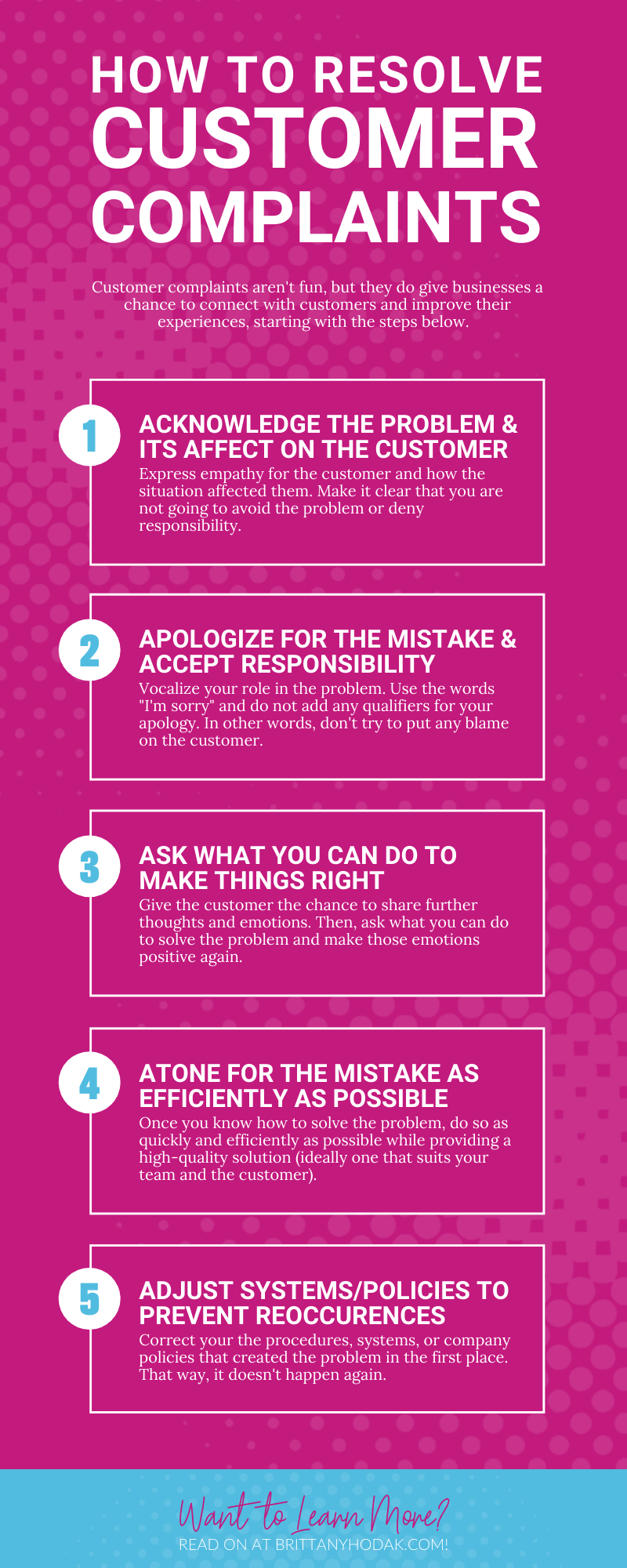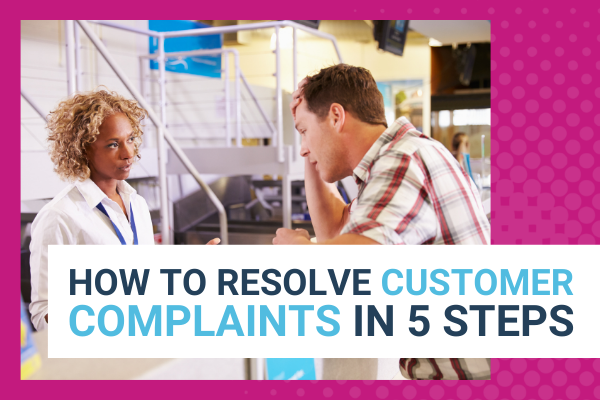Let’s face it: customer complaints are intimidating. In today’s world, reviews and word-of-mouth are everything. They’re what boosts a brand’s performance on social media, search engines, and even amongst local communities. However, what if we said customer complaints can actually be a good thing?
Though it sounds crazy, customer complaints are an opportunity to turn a situation around. They’re a chance to do better and serve future customers more effectively. When a customer is unhappy, they’re likely to voice this feeling. Only 1 in 25 unhappy customers actually voice their complaints directly to the company, whereas 13% share this complaint with 15+ people.
When a customer takes the time to highlight a problem they have with your business, you have the opportunity to investigate deeper. While many brands mistakenly assume they want to avoid complaints, the opposite is often true. What would you rather have: customers complaining to others or customers complaining to you? The answer is always the latter.
It’s time to shift the mindset around customer complaints. Yes, these are intimidating and disheartening. It’s never fun to recognize that you made a mistake or that your customer experience didn’t live up to expectations. Still, this is an opportunity to resolve the situation and do better. In this guide, we’ll share how to resolve customer complaints in 5 steps. It’s all about taking proactive action and being responsible.
Acknowledge the problem and how it affected the customer.
First, you can’t brush off customer complaints. Remember, most customers don’t take the time to complain at all. They voice their concerns online, in reviews, or to their friends and family. This customer took the time to raise this problem with you directly, so they deserve your consideration and focus.
Take the time to understand what their problem is and why they’re upset. In reality, most people just want to feel heard. Let them know you see how this affected them, and you take these matters really seriously. A reported 79% of customers who shared complaints online had their complaints ignored. You never want your own customers included in this percentage. Make sure they feel heard, valued, and understood.
To see this in action, let’s look at an example of a company that always acknowledges users’ problems. The streaming service Hulu does this beautifully on their Twitter support account. They respond to each and every customer complaint, empathizing with their concerns. Most importantly, they also provide extra steps the customer can take to learn more. It seems simple because it is, but it works.
Apologize for the mistake and accept responsibility.
Next, always, always, always apologize. Whether it was your fault, another team member’s fault, or no one’s fault, accept responsibility. There is never a good time to play the blame game. Frankly, the customer doesn’t care who is responsible. They want someone to take ownership.
As the author of the Apology Impulse explains, the corporate world often fails to say sorry properly. There’s this dance around the magic words (“I’m sorry”). The company instead focuses on what author Sean O’meara calls the “faux-pology” by expressing limited fault or staying passive.
With that in mind, what makes a good apology? It’s all about not adding insult to injury. You have to recognize that you’ve made a mistake. People really only want to know what you’re going to do about it. This isn’t a time to list your accomplishments or share why you’re trustworthy. It’s a time to own up and make amends.
Even big-name companies aren’t immune to this. For instance, the vacation rental platform Airbnb famously faced numerous complaints of racial profiling and discrimination. Instead of deflecting blame, they took a proactive approach and apologized outright.
Not only did their CEO issue a strong public apology, but they also published a 32-page report about inclusion and ways to prevent discrimination in the future. Their “We Accept” advertisement famously played at the 2017 Super Bowl to show their commitment to acceptance and change. Through their willingness to take responsibility, they effectively changed their public image.
Ask what you can do to make things right.
Moreover, you need to ask what you can do to make things right. Your customer service team needs to feel empowered to handle these complaints, solving them as soon as possible. You don’t have to guess what your customer wants—just ask.
It’s surprising how often your customers already know what they want you to do. Though they aren’t always ‘right,’ you should always listen. In most cases, they actually ask for less than you initially thought. This is especially true if you write an honest, meaningful apology.
How can you make things right? Here are some ideas:
- Offer a full or partial refund
- Send a new version of the product/download/service
- Provide a coupon for a future product/service
- Upgrade on a purchase
- Send a free gift certificate
Work together to decide the best course of action as a team. You both want the best outcome, so there doesn’t need to be tension throughout this process. A company constantly praised for its ability to turn around the customer experience is the Walt Disney World Resort. The social hashtag #CastCompliments is used to highlight exceptional Disney team members who weren’t afraid to solve guest concerns.
In this #CastCompliments exchange below, one guest shares how a server in the Magic Kingdom was quick to fix their order after it was made incorrectly. She even took the time to make sure the steak was done to perfection the second time, proving that she took this complaint seriously. Thanks to this experience, the guest can’t wait to come back.
Atone for the mistake as efficiently as possible.
Not only do you want to find the right solution for a guest’s concern, but you want to find it quickly. Time is truly of the essence. In fact, customers expect businesses to respond to their emails within an hour. While an hour might be hard to manage, you should have a system in place for handling problems quickly.
When complaints move up the chain of command, they just become more expensive. This also frustrates customers who likely don’t understand why their concerns couldn’t be handled right away. This is why empowering your employees to take charge to solve problems is so important. The more steps a user has to take to reach a resolution, the less likely they’ll stick around long-term.
How can you make sure your response is efficient? First, be prepared with potential solutions before a concern is even brought to your attention. Having a go-to offer, discount, or refund available ensures your team knows exactly what to do. Most importantly, avoid escalating to another department or leadership team. It’s important to make the process as simple for the customer as possible.
An example of a brand that isn’t afraid to own up and solve the problem quickly is Zocdoc. This app allows patients to book appointments with healthcare professionals on their phones, but sometimes scheduling errors happen. Though these errors are the result of doctors not updating their schedule, Zocdoc takes full responsibility. Better yet, they offer a free gift card right away as an apology for the poor experience.
Adjust your systems or policies to prevent it from happening again.
Last but not least, take the time to prevent this problem from happening in the solution. When customers see real change in the businesses they support, they feel valued. Their opinion is important, and they’re more connected to an organization.
Remember how we said customer complaints can be profitable? If you turn these complaints into a chance to do better and create new systems, they actually improve your customer experience. Create new systems, policies, and solutions to prevent these issues in the future. You’ll turn casual users into superfans, and create an experience worth raving about.
The meal delivery kit Blue Apron makes it simple for customers to solve concerns quickly. Because they know their kits sometimes arrive in poor condition due to delivery carriers, they added a reporting tool right in their app. This makes it easier for the service team to look into the problem quickly and issue a refund or replacement right away.
Because they noticed a large number of complaints about issues with boxes being late or not having the right ingredients, they built this into their system. Now it’s easy for customers to get the support they need quickly, ensuring a seamless experience with each order. This is what it means to be proactive about the customer experience.
Turn Every Complaint Into an Opportunity
In conclusion, customer complaints don’t have to be intimidating. Consider them as an opportunity for growth. If you don’t know what your customers are thinking, how can you improve? Just because a customer isn’t happy doesn’t mean they’re lost forever. In fact, the service recovery paradox argues just the opposite. Customers are actually more loyal once you turn a situation around.
The next time you get customer service complaints, change your thinking. You can either fumble through an apology or create lifelong superfans. The world could use better company apologies. Make the change today and see a world of growth.

